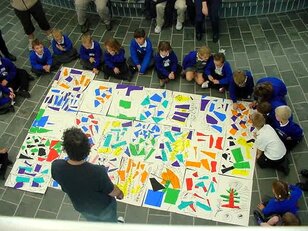|
Abstract
This paper evaluates the outcomes of an art project and the value of developing creative partnerships in the local community. My role as 'artist in residence' was to introduce 80 Primary School pupils to the work of the artist Bryan Wynter in three classes exploring 1 aspect of his diverse work:- 1. The Cornish Landscape paintings 2. Kinetic Sculptures based on the Elements in the local Environment 3. Abstraction The objectives for the project were: 1. Understanding - (historical context / intentions / materials / formal qualities / influences) 2. Interpretation - (empathy in a contemporary context) 3. Response - (development / use of ICT) A group of older pupils managed, reported on and recorded the project and the pupils work was hung in the Tate St Ives. The Earth, Air, Fire, Water Project was initiated and funded through BECTa and the Tate Gallery St Ives in 2002. |
Bryan Wynter
1935-1945 Early painting of the Cornish landscape incorporating a mono printed ground which was used as an experimental ground for over working suggestions specific content - tin mines, rock faces and birds. 1960 Experimentation with movement through simple kinetic motor driven hanging pieces of cards reflected by mirrors. Wynter described this pieces IMOOS (Images Moving out onto Space) These may be interpreted as the artists attempt to convey 3-dimensional movement in space 1970 Large abstract paintings of the elements including Waterflow. Wynter owned a glass bottomed canoe which enabled him to observe water movement at first hand on the North Atlantic coast. |

|
|
||


